Excerpts from Jim Conrad's
Naturalist Newsletter
entry dated April 6, 2023, with notes from near El Cerrito, 5kms south of Tequisquiapan; bedrock volcanic andesite, an intermediate rock between basalt and rhyolite; elevation about 2,000m (6600 ft), Querétaro state, MÉXICO
(~N20.47°, ~W99.89°)
ALKALI MALLOW
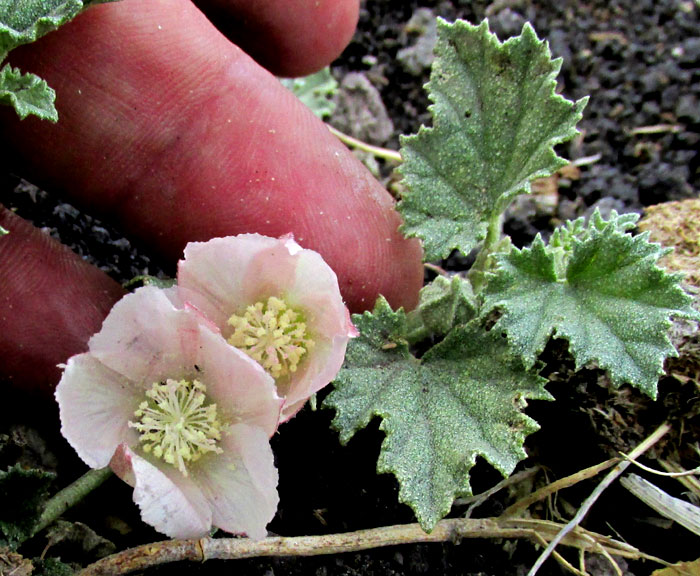
On the southeastern side of El Cerrito, the town's reservoir is completely dry. This is the dry season and the last rainy season didn't develop as in the past. Most of the reservoir's area that's underwater during normal times is without vegetation. However, one spot about the size of a house was densely covered with the above flowering herb, looking surreally luxuriant and out of place in the glaring sunlight. A side view of the flower showed itself as more colorful than the whiteness seen from above:
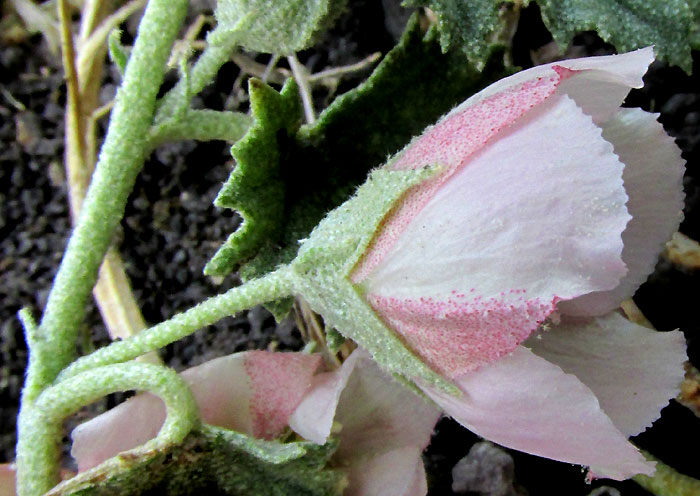
Note the corolla's curious pink, mealy looking zones. I read that inside this plant's flower buds the corollas are covered with pink hairiness, which falls off when the corollas unfold, and that sometimes corollas fold upon themselves within the bud. I think the pink zones must represent where the corolla unfolded late during its opening. Notice the corolla lobes' jagged margins. In glaring sunlight, some corollas were very pale yellowish, but the photos didn't capture that. The yellowishness and pinkness made an attractive combination. Also, note that the the corolla lobes are very slightly asymmetrical, the one seen above slightly bulging on its lower, pink side. Breaking open a blossom reveals the plant family we're dealing with:

Numerous stamens with their filaments united at their bases into a staminal column surrounding the style, and several stigmas, as well as other features, take us to the big, variable Hibiscus Family, the Malvaceae. Pinching off the flower's upper parts so that only the ovary at the bottom of the calyx is visible, the fruit type is something typical of that family:
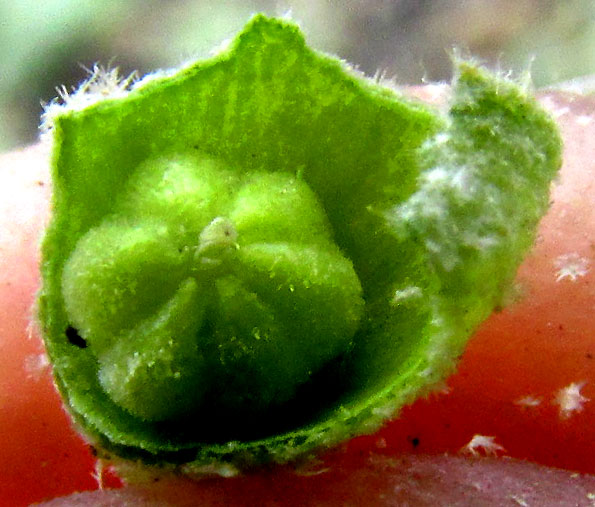
The ovary is partitioned into six segments. Notice on my fingers at the picture's lower right the tiny, white, snowflake-like items, which have come loose from the calyx. Those, along with regular hairs, densely cover this plant, overall giving the vegetation a silvery, scurfy appearance. The loose items are intermediate between scales and the star-shaped, branched hairs referred to as stellate hairs. The resulting silvery vestiture protects against particularly intense sunlight; it reflects much sunlight, while letting enough pass through to power photosynthesis in the green leaves.
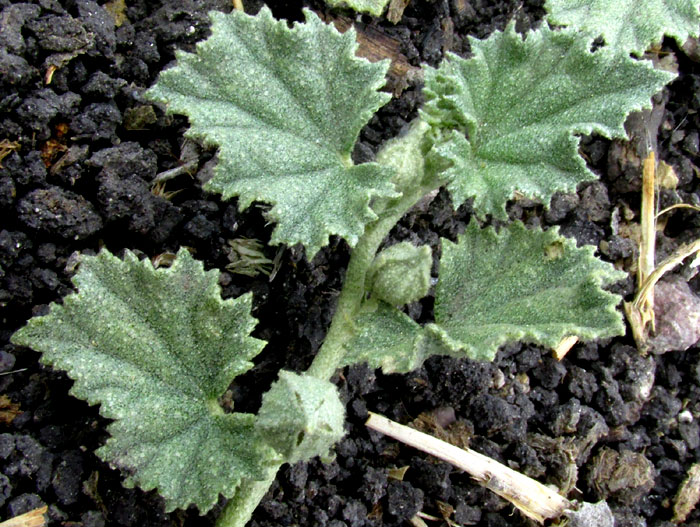
Besides the tendency to trail along the ground, another field mark shown by the herbage is that its leaves alternate along each stem. Here's what clusters of young plants look like:
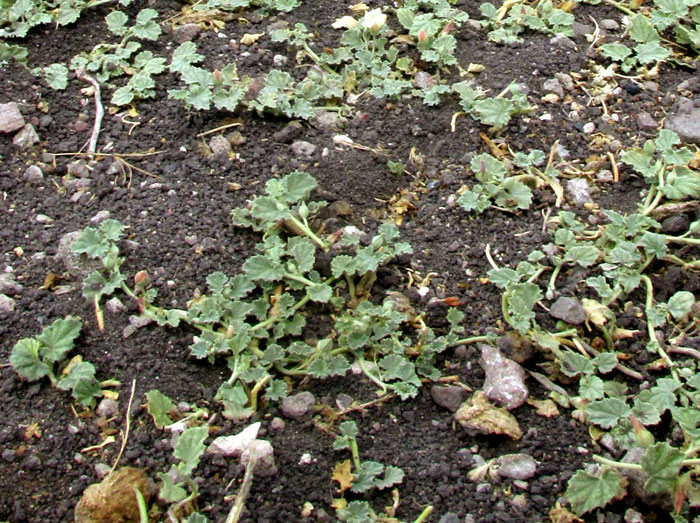
Finally, noting the diffuse patches of whiteness on soil in the background, here's the habitat where our house-size population thrives on sediment that during most of the year during normal seasons is submerged:
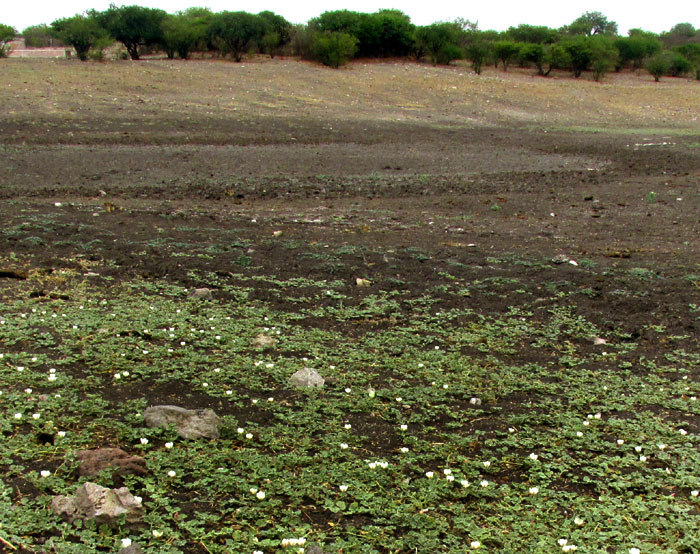
All the above observations led to MALVELLA LEPROSA, known by several English names, perhaps the most frequently used being Alkali Mallow. That name reflects the plant's frequent occurrence in habitats exactly like what's shown above -- lake edges, canals, often in moist soils that are highly saline or alkaline. In such environments, salt, and minerals causing high pH levels like calcium, sodium and magnesium, accumulate atop the soil as water evaporates.
Malvella leprosa is distributed from the drier areas of western North America south through most of upland Mexico, as well as in southern and western South America, plus it's invasive in southeastern Australia and Mediterranean Span. The Flora of North America states that "The species is considered to be a noxious weed in Arizona and California and increasing as saline soils increase."
Identification of Malvella leprosa was a bit tricky. The Flora of North America, California's Jepson eFlora, and the Flora del Bajío covering our area, all claim that the schizocarp fruits of Malvella species produce 7-10 mericarps, but ours clearly has 6. Flora technical descriptions don't mention the corolla's pink zones, which are so conspicuous in our pictures -- maybe because the feature doesn't show up in dried herbarium specimens. Technical descriptions describe 1-3 small, very slender bractlets on pedicels below each flower but, at least in our plants, those fall very soon after the blossoms open, leaving no clear trace that they've ever existed. The scurfy hairiness/scaliness is so unusual and variable that technically it's awkward to describe. However, in the end, our plants could hardly be anything else.
California's Jepson eFlora says that our plant is reported to be toxic to sheep and possibly to other livestock. This may explain why such a lush population survives where sheep and cattle on a daily basis pass through on their way from stalls and backyard corrals in town to browse upslope in the scrub.